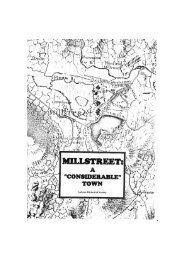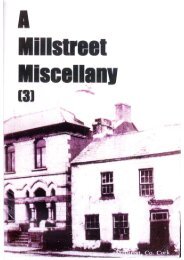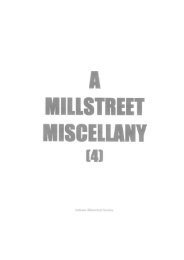The 'Boys' Of The Millstreet Battalion Area - Aubane Historical Society
The 'Boys' Of The Millstreet Battalion Area - Aubane Historical Society
The 'Boys' Of The Millstreet Battalion Area - Aubane Historical Society
You also want an ePaper? Increase the reach of your titles
YUMPU automatically turns print PDFs into web optimized ePapers that Google loves.
WITNESS STATEMENT NO. 787<br />
CON MEANEY, RATHROE HOUSE, DERRINAGREE, BANTEER, CO. CORK<br />
Captain, Mushera (Co. Cork) Coy. Irish Vols.<br />
O/C. 7 th<br />
Batt'n. Cork II Brigade, post 1916;O/C. 1 st<br />
Batt'n. Cork IV Brigade, later.<br />
Activities of Irish Volunteers, North Cork, 1916-1921.<br />
Conditions, if any, Stipulated by Witness: Nil<br />
O/C. 'I' Company and O/C. <strong>Battalion</strong> Police, 1 st<br />
We who were on the run got home some<br />
time prior to Christmas, 1916, as interned<br />
prisoners were being released from Frongoch<br />
and then with the general release it was felt safe<br />
to show ourselves once more without fear of<br />
arrest. We had been on the run since Easter<br />
Week.<br />
<strong>The</strong>n in the early Spring of 1917 reorganisation<br />
of the Volunteers commenced. This<br />
took the same form as before the Rising and was<br />
started when a number of us met under cover of<br />
night and decided to reorganise. <strong>The</strong> result was<br />
that that phase of reorganisation was completed<br />
by early Summer of that year.<br />
Gradually the original four Companies<br />
were developed as the movement spread out and<br />
the formation of a <strong>Battalion</strong> with Staff<br />
completed the organisation.<br />
<strong>The</strong> 17 th<br />
<strong>Battalion</strong> was organised in the<br />
early Summer of 1917 as a Unit of Cork Brigade<br />
I.R.A. It originally consisted of eight<br />
Companies, with number increased to ten in<br />
1920 and to eleven in 1921 during the Truce<br />
period. This organisation of the men of Millsteet<br />
<strong>Area</strong> into a <strong>Battalion</strong> of the I.R.A at this period<br />
was merely a resurrection of Companies<br />
moribund as a result of arrests and raids in the<br />
<strong>Area</strong> after the 1916 Rising.<br />
<strong>The</strong> <strong>Battalion</strong> was originally organised as<br />
a Unit of the Irish Volunteers in 1914, after the<br />
disintegration of the Irish National Volunteers.<br />
It was so painstakingly organised that it was<br />
considered by the Volunteer Executive as an<br />
<strong>Area</strong> ripe for development as a nucleus for the<br />
<strong>Area</strong>s of Duhallow and Muskerry. As a result of<br />
this, the Executive decided to send Patrick<br />
Pearse to <strong>Millstreet</strong> in 1915 to address a meeting<br />
of the public and a Convention of Volunteers. It<br />
is a significant fact that all those Volunteers<br />
attending the Convention, as well as others<br />
associated with them, were interned after 1916<br />
and had to go on the run until the release of the<br />
internees at Christmas, 1916.<br />
11<br />
<strong>Battalion</strong>, Cork IV Brigade.<br />
Herewith are the names of those interned<br />
and of those who escaped by going on the run: -<br />
Jeremiah O'Reardon,<br />
Michael O'Reardon,<br />
Jim Buckley,<br />
Pat Carmody,<br />
Jerry Twomey,<br />
Con Murphy,<br />
Tim Murphy,<br />
Liam Buckley,<br />
Con O'Callaghan,<br />
Men on the Run<br />
C. J. Meaney,<br />
William Kelleher,<br />
James Hickey,<br />
Con Meaney,<br />
Corner House, <strong>Millstreet</strong>.<br />
Corner House, <strong>Millstreet</strong>.<br />
Church Street, <strong>Millstreet</strong>.<br />
Main Street, <strong>Millstreet</strong>.<br />
Main Street, <strong>Millstreet</strong>.<br />
Ballydaly, Rathmore.<br />
Ballydaly, Rathmore.<br />
Kilcorney, Banteer.<br />
Mill Lane, <strong>Millstreet</strong>.<br />
Coolinaree, <strong>Millstreet</strong>.<br />
Drishanebeg, <strong>Millstreet</strong>.<br />
Main Street, <strong>Millstreet</strong>.<br />
Gurraneduff, <strong>Millstreet</strong>.<br />
Jeremiah Reardon and MI. Reardon<br />
were father and son. Jeremiah Reardon and<br />
James Buckley were old men and members of<br />
the Fenian Brotherhood.<br />
When Cork 2 nd<br />
Brigade was formed in<br />
1919, the 17 th<br />
<strong>Battalion</strong> became the seventh<br />
<strong>Battalion</strong> of the new Brigade. Owing to loss of<br />
despatches in 1921 its number was changed to<br />
the first, which number it retained after the<br />
formation of the Cork 4 th<br />
Brigade.<br />
<strong>The</strong> 'lost' despatches contained the<br />
names of all the <strong>Battalion</strong> <strong>Of</strong>ficers, as well as the<br />
names of all the <strong>Of</strong>ficers of each Company in the<br />
<strong>Battalion</strong>. <strong>The</strong>y were actually lost to the enemy<br />
as they were captured in a raid.<br />
It will be realised that as a result of the<br />
post-1916 internments and raids, the difficulties<br />
of reorganisation in 1917 were greater than<br />
those in areas which had not been so forward<br />
nationally. Nevertheless, men were found in<br />
every Company <strong>Area</strong> to carry on the work and<br />
the names of those to whom credit must be given<br />
for the work of reorganisation are set down<br />
here.





